"The areas of secular education considered liberal have their foundation in classical antiquity and were codified in the medieval period into a distinct set of seven, with two subdivisions. The upper division, the quadrivium, consists of Geometry, Arithmetic, Astronomy, and Music; while the lower division, or trivium, is made up of Grammar, Logic (or Dialectic), and Rhetoric. [..]
The tradition of artistic representation of the Seven Liberal Arts may be traced to the fifth-century work of Martianus Capella*; his allegorial treatise, 'De Nuptiis Philologiae et Mercurii Libri Novem' ['Satyricon'], describes the Seven Liberal Arts as personified female figures with specific attributes and companions." [source]

Musica
Concentum inter se, et discrimina grata
sonorum aure erudita deprehendit musica
sonorum aure erudita deprehendit musica
Music, a woman, sits at a harpsichord; another female plays a lute and two youths embraced by an elder sing and hold tablets; a man sits at right and plays on a lute and the ground is strewn with instruments; more instruments hang from the wall, including a bagpipe and trombone.
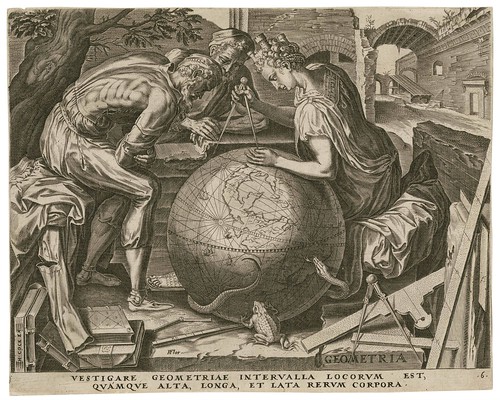
Geometria
Vestigare geometriae intervalla locorvm est,
qvamqve alto, longa, et lata rervm corpora
qvamqve alto, longa, et lata rervm corpora
Geometry, a woman, uses compasses to measure the globe watched closely by two male figures; various measuring devices are in the foreground together with academic tomes.
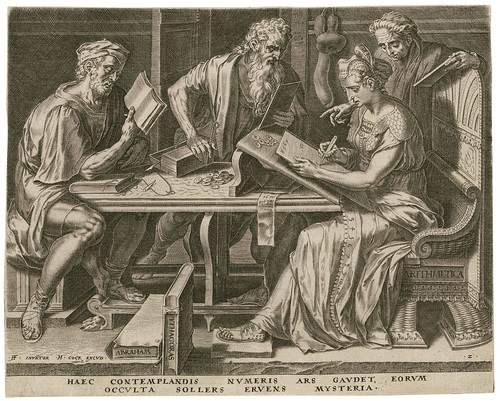
Arithmetica
Haec contemplandis numeris ars gaudet,
eorum occulta sollers ervens mysteria
eorum occulta sollers ervens mysteria
Arithmetic, a woman, seated at a table inscribes a tablet accompanied by an elderly woman and two male scholars; the elderly woman stands over her and instructs her; her dress is numbered "1234..." and two tomes are labelled "ABRAHAM" and "PYTHAGORAS".
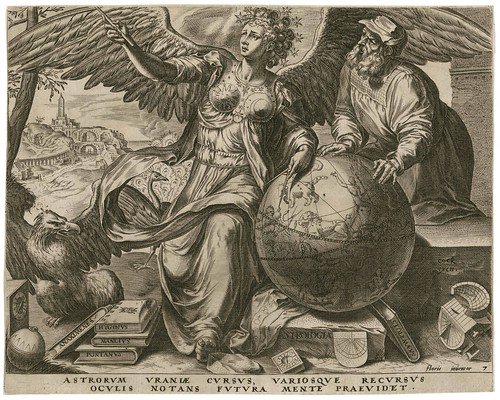
Astrologia
Astrorvm Vraniae cvrsvs, variosqve recvrsvs ocvlis
notans fvtvra mente praevidet; Astrorum Uraniae cursus
notans fvtvra mente praevidet; Astrorum Uraniae cursus
Astrology, a winged female personification, leans besides a globe with zodiacal star symbols; on the ground are various scientific instruments and sundials etc; an eagle spreads its wings and stands besides a pile of books labelled "ANAXIMENES" etc.

Dialectica
Vti hominem ratione docet dialectica quare
merito artium apicem magnus hanc plato vocat
merito artium apicem magnus hanc plato vocat
Dialectic, a woman, seated on a wicker chair, engages in conversation with an elderly philosopher; she rests her feet on a stack of tomes labelled "ARISTOTELES" etc; a bird sits on her head, an eel is wrapped around her arm and a frog sits on an upright tome.
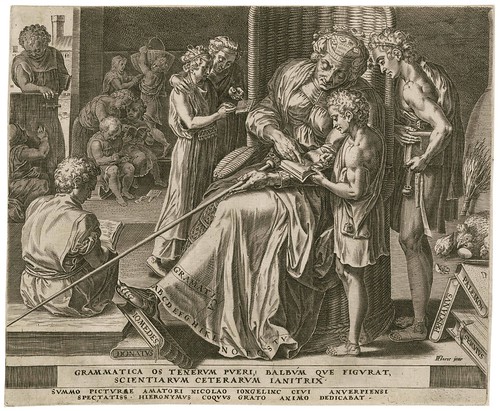
Grammatica
Grammatica os tenerum pueri, balbum que
figurat, scientiarum ceterarum ianitrix
figurat, scientiarum ceterarum ianitrix
Grammar, a seated old woman, teaches a young boy standing besides her the rudiments of reading and writing; she holds a long staff, leans over and points to the pages of the book held by the youth; her dress has the letters of the alphabet; in a school room with students and various labelled scholarly tomes.
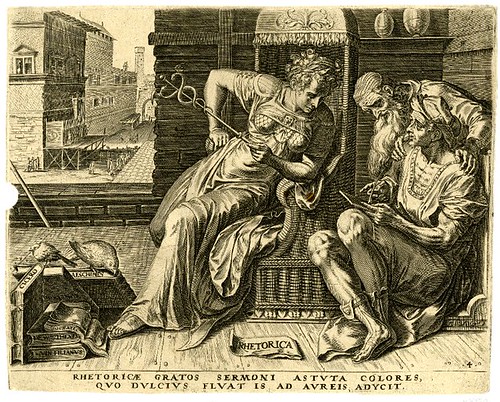
Rhetorica
Rhetoricae gratos sermoni astvta colores
qvo dvlcivs flvat is ad avreis advcit
qvo dvlcivs flvat is ad avreis advcit
Rhetoric, a seated woman, holding a caduceus, leans over and engages with a seated man writing on a tablet; an elderly man with a long beard places his hands on the shoulder of the younger scholar; two birds, including a parrot, sit on a pile of books labelled "CICERO" etc on the ground.
The allegorical mannerist images above were engraved by Cornelis Cort (after Frans Floris) and published in Antwerp in 1565 by Hieronymous Cock.
"One of the most famed printmakers of his day, Cornelis Cort was admired for his ability to translate tonal qualities into a black and white engraving. Cort accomplished this in part through an important technical innovation: It is the nature of an engraved line, cut as it is with a tool (the burin) whose cutting edge comes to a sharp triangular point, to begin as a point, swell almost imperceptibly at the center, and narrow to a point again at the end. Cort exploited this quality of the burin line; by varying his pressure on the tool as he gouged the plate, he developed a flexible line that becomes thicker and thinner along its length, creating various degrees of darkness without adding additional lines."
The first six plates above come from the Folger Shakespeare Library Image Collection [homepage]; the last picture (and most of the notes) is from the BM.
See: The Seven Liberal Arts at New Advent.
About a year ago I was talking with my teenage niece and I asked her if there had ever been any instruction in web searching as part of her regular school work (there hadn't been). My niece and her mother both expressed surprise when I suggested that the art of searching involved more than just pointing a browser to google.com. Considering the amount of time and energy we devote to searching for information online, it's logical to assume that life would improve (yes, marginally!) if we were all better versed in the tricks and skills associated with formulating useful search queries.
I'm no expert on search and only wish I remembered and used more than a handful of the advanced techniques from the various cheat sheets around the traps. Web search is usually pretty easy most of the time of course, particularly nowadays, with all the options available to modify the queries. In terms of school I had more in mind the idea of learning the strategies and paths one might take - beyond advanced operators - for complex searches, like when it's better to hit specific types of databases or when you should give up and email somebody, for instance. It's this development of lateral thinking that I would have thought merited a bit more than hit-or-miss / trial-and-error approaches in school classrooms.
If web search is itself an occasionally complicated procedure, it usually pales by comparison to the elaborate tasks involved, more often than not, in image searches; depending on the target picture desired. One of the main difficulties comes from the translation of a text query into a visual result. Sure, that's stating the bleeding obvious, but the problem is that the desired image might not have the words "red hat" or "dubois" or "15th century engraving", or whatever your search term is, in the alt or title tags or as text on the webpage near the target. So searching with the usual text terms can be fruitless or at least less successful.
Now I love google images and use it all the time - I use it as much as a conduit to discover background information in fact - but it's only ever partially useful: a good place to start in the same way as wikipedia can be a good place to start when looking for textual background and links. We now also have the emerging dimension of similarity based image search which I haven't used a lot, but it's another weapon in the arsenal.
I see image search (much like web search in a way) as a problem solving exercise: some people like doing crosswords, I like hunting down visual materia obscura. I don't think it would be particularly useful to outline the steps I take to solve a specific query - they are all individual and the steps I might take will differ accordingly - but I thought it might be useful to some people if I post all the sites I have in a drop-down 'art' folder in my browser. If you are reading via a feedreader, there are a whole bunch of links under 'resource sites' in the sidebar of BibliOdyssey - that include some of these listed below - but they tend more towards the library and exhibition types. The links in the browser folder are where I actually go to find stuff when I'm looking to fill out a post with more images than are contained in a single book or from a single web exhibition site, for example. They are necessarily skewed towards the prints and graphics but many of them are generalist art sites and useful beyond my obsessional parameters.
This list is in order of value (to me!). That value is basically a function of how productive of images they are combined with how much I like the site. Science and Society is at the bottom of the list because the bastards watermark copyright-free material; but they are a very useful resource nevertheless because of the very thorough list of linked image descriptors - "hat", "girl", "engraving", etc etc - and they often have unique background information. I think all but one of these links goes directly to a page with a search box (the Lyons site is timer based so you have to click through to commence a session). So I hope these prove useful to someone...
[Incidentally, this post comes via an entry on the WorldCat blog announcing the inclusion of a large record collection (including images) from an enormous consortium of libraries and museums, into the WorldCat database. It's perhaps a little clunky, but it's this sort of consolidation - like the collection search links for the Smithsonian and the V&A below - that makes tracking down obscure material that much easier.]
British Museum Prints Database
New York Public Library Digital Gallery
Fine Arts Museum of San Francisco
La base Estampes de la Bibliothèque municipale de Lyon
Rijksmuseum
Smithsonian Institution - Collections Search Center *NEW*
Metropolitan Museum of Art
Victoria & Albert - Search the Collections *NEW*
Culture.fr: le portail de la Culture
Graphische Sammlung Stift Göttweig (Austria)
Ornamental Prints Online (Berlin, Prague, Vienna)
Banque d'Images - Centre de Recherche: Chateau de Versailles
Los Angeles County Museum of Art
The National Gallery of Art
Virtuelles Kupferstichkabinett
Inventaire du Département des Arts Graphiques (Musée du Louvre)
Museum of Fine Arts, Boston
The Cleveland Museum of Art
Minneapolis Institute of Arts
The Detroit Institute of Arts
The State Hermitage Museum (St. Petersburg)
Zeno Image Database (German)
Collage: Guildhall Print Room & Art Gallery
Science & Society Picture Library
Later: I should add that I don't necessarily use these sites, per se, to find a desired image. Often times they merely provide clues: alternative names, associated book and print titles, dating evidence, more examples by the artist or genre in question and sometimes lack of results can hint whether or not further exploration is likely to be of value. And obviously this list is just the beginning. The information gleaned in one or more of these sites may just lead back to google image search and/or on to more specialised portals and the like.
-------------------------------------------------------



















17 comments :
I was interested to read about your discussion with your niece and her mother.
I suspect many people are not aware that searching the internet is an art, or at least may require some artful dodging if you want to be effective. Particularly non-intellectual friends of mine have difficulty finding things outside of a few special sites they visit such as chat rooms, or wikipedia. But not only such friends: an IT colleague of mine recently turned out to be unfamiliar with google advanced search.
I have been through a good deal of trial and error to arrive at my current techniques for Google (I'm talking about text searches only). The "basic examples" on the google cheat sheet are all very well - but what words or phrases should you think about choosing for all those ORs, pluses and minuses? The matter gets trickier in languages more inflected than English (I speak German as well).
And of course you need to know a bit about how the given search engines works. I'm not even sure I know enough about the Google engine, though it would be easy enough to find out.
For instance, does the order in "X Y Z" (X, Y and Z are single words) affect the outcome? I had been working on that assumption, but when I just now searched "thatched roof" (in "all these words", not "this exact wording or phrase") I got 154,000 hits, but "roof thatched" got me 1,010,000 hits. I hadn't been expecting that.
As I indicated, I would like to be able to find effective tips to give to friends of mine who are not so language-reflective as myself, but it ain't easy.
I see only two principles so far, in the current state of the art. One is trivial in a profound sort of way. Namely, that you will find what you're looking for only on sites written by people who think and write as you do when you formulate the search. So, for instance, to search for something legal, or having to do with a public authority, you need to know exactly how civil servants talk about that thing.
The second principle is related to the first. Namely, that these OR/+/- techniques are probably just too clumsy in principle. We need different approaches, different algorithms. How to search for good search techniques??
Hi peacay, it must be a year since I bought copies of your book and still find it fascinating. I'm still into old fish but haven't done much searching this year. Your thoughts on searching are useful and thought provoking. Certainly I need brushing up on my techniques, especially as things are changing so rapidly. Good to find you again, thanks to a reminder by a good blogger friend. Seasons greetings, Carol
You express some powerful ideas with this post. In my business (art on old paper), I spend a great deal of time doing Google searches for both text and images. It is by turns spectacular and frustrating, but I simply couldn't do without it. I'd be spending all my time at the local library...
Wow. Very nice post. Well done to you....
Thanks for the post. I recently found some nice artistic representations of the liberal arts at Wikimedia Commons and used them in a presentation. At that time, I searched for more detailed descriptions of the images without much success.
About searching for images . . . I often use a web crawler (Pandora) for searching Google Images and other sites when I want to get a quick idea of what's out there. It usually pulls in a little under 1000 images in a few minutes. But if I need an image for my blog or a presentation, my first stop these days is Wikimedia Commons. It's a good resource, but like any, it has its limits.
So I appreciate your list of resources here. Very helpful. Just to be clear, do you mean that all of these sites provide images in the public domain and/or allow use on blogs, slide shows, and the like (besides the watermarked images from S&S)?
Thanks.
Stuart, I've never much looked for search help other than the advanced operator stuff I linked. I like using quote marks around phrases and I like using the + operator (and a handful of other functions now and then: printing out the linked cheatsheet will help).
You might be right in some cases using search queries in the language style of the subject matter, but I don't see that as a universal concept. Carefully chosen keywords (and using similar words a la thesaurus) remain the primary input I think. That doesn't tell you that you're better off going to, for instance, a .gov site or a library site or some other specialised repository rather than hitting s search engine.
This is where I think a school class is indicated: set a range of complicated questions and then go through what people did to get the answer and discuss the thinking and decisions made along the way. I'm sure a set of vague principles can be stated but I think people need to both a) go through the search process themselves and b) see how others solved the same problem.
Trial and error may establish a way for you to find some type of info, say, but you just don't know if that's the best/smartest way. Again, I'm not sure how this stuff can be communicated well without activity and feedback.
Randall, you wrote: "Just to be clear, do you mean that all of these sites provide images in the public domain and/or allow use on blogs, slide shows, and the like"
I do not mean any of this.
I have stated what I do and where I go. That should not be taken as commentary on any intellectual property rights whatsoever and just because I do what I do does not mean I advise anyone to emulate me.
In other words, anything you do should not rely on my activities as either precedent or authority. You wear your own risk (as I do).
{sorry if that sounds a bit terse or whatever, but I have to be careful what I say for fairly obvious reasons}
Hi Peacay, I must tell you that when asked the other day which was my favourite blog to peruse ... I didn't need much time to consider... Yours was the ONE. ( and the thing is I am not one given to picking favourites...)
it is clean, informative, illustrated and appeals to me so much...
Thank you!!!
Really interesting! Thanks for your hard work!
Thanks for the clarification to a naive question.
I am working on a committee at school (CCBCMC) preparing for Mid-Atlantic States accreditation process.We are called the Information Literacy Task Force and among our tasks is how to make sure students learn to do efficient online searches.
I would like to share this discussion with my group.
Thank you for your usual excellent work.
DD
I think Musica is playing what would now be technically called the virginals (a member of the harpsichord family), or else it's a clavichord (which looks similar but has a different sound mechanism, which I didn't know until I looked them up just now, having only occasionally played but not studied either one).
It would be a very fine thing if somebody actually taught the niceties of internet searching. Mine are pretty much self-thought-out and so while not too bad they could definitely be improved upon.
Yes, I think that is a virginal.
Peacay, your introduction says that Astronomy is one of the seven liberal arts, but your description of the subsequent picture says it is Astrology instead. I only raise this apparent inconsistency because I had a hard time figuring out how Astronomy could possibly qualify as one of the liberal arts. Astrology would be a little easier to understand.
By the way, that personification of "Grammar" looks just like my 5th grade teacher, Viola Newman.
Thanks David. I think there's something of the fluid about the titles and definitions of these subjects. That fluidity is borne out both in the seeming contradiction between astronomy/astrology AND the inclusion of what we perceive as as a scientific subject among the 'liberal arts'.
In other words, there is no mistake here. The intro was an encyclopaedia quote and the plate in question is self-titled as astrologia. It all depends on which source you listen to: and understandable as well, given that the history of this loose educational collective goes back some few thousand years.
Peacay, isn't that just like those darn liberal arts? Subjective, inconsistent and mercurial to the end.
That scholar is using an iPad to check up on Arithmetic. Must be Jobs referencing Wolfram Alpha!
I love this style and craft. Thanks for the note about Cornelis Cort.
Everybody should know this, and be able to use them freely enough to live by. Love this, knowledge is power in many different forms after all.
Post a Comment
Comments are all moderated so don't waste your time spamming: they will never show up.
If you include ANY links that aren't pertinent to the blog post or discussion they will be deleted and a rash will break out in your underwear.
Also: please play the ball and not the person.
Note: only a member of this blog may post a comment.